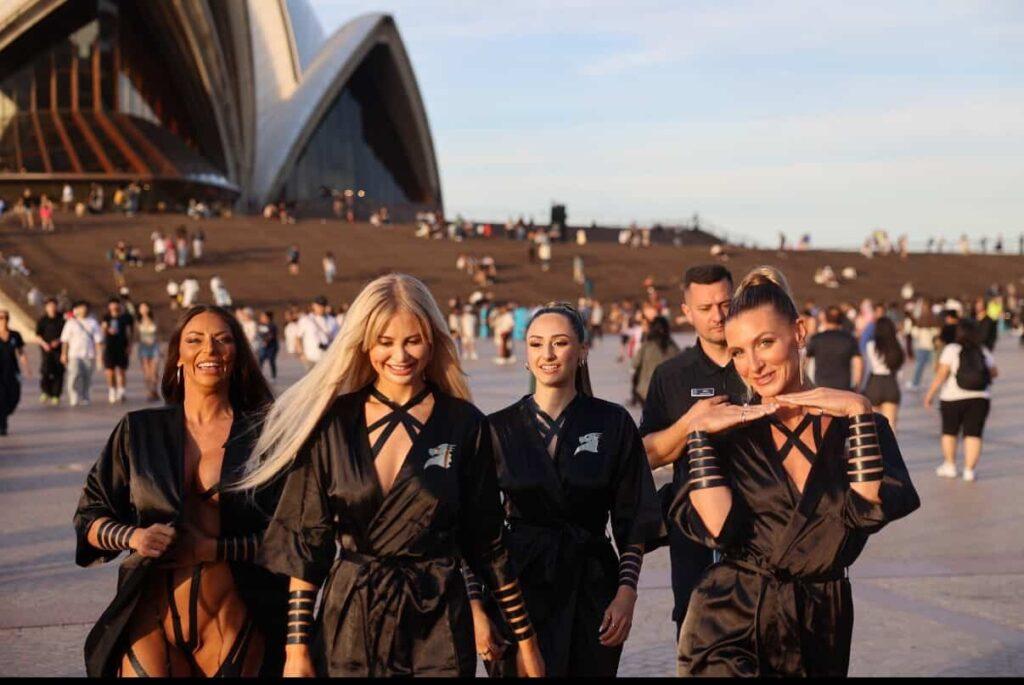THE STUNT THAT STOPPED SYDNEY
Sydney woke up to chaos, creativity, and controversy when the Black Tape Project landed at the Sydney Opera House, wrapping models in nothing but strips of black electrical tape — and a whole lot of attitude.
No permits. No warning. Just pure, unfiltered performance art in one of the most heavily policed public spaces in Australia.
The stunt — conceived and executed in collaboration with publicity provocateur William Stolk — blurred the line between fashion show and protest, body art and body politics.
Models stood confidently in front of the Opera House sails, their forms transformed into geometric living sculptures under the Sydney sun.
“This was never just about aesthetics,” says Stolk. “It’s a calculated disruption — a way to challenge public comfort zones around nudity, body autonomy, and artistic freedom in shared space.”
THE ART OF SHOCK
The Black Tape Project has built a global reputation for turning skin into canvas — a high-voltage collision of body art, fetish fashion, and performance. From Miami to Ibiza, their minimalist tape creations have appeared at fashion weeks, nightclubs, and festivals worldwide.
But in Sydney, they took things further.
The Opera House stunt wasn’t a scheduled show — it was a guerrilla activation designed to interrupt.
Security eventually stepped in, but the performance wrapped before any arrests could be made.
Within hours, footage flooded social media, sparking debate over public decency, censorship, and whether art should ever ask for permission.
“The system loves to control the narrative,” says Stolk. “So the best way to start a conversation is to hijack the stage they built to ignore you.”
SYDNEY, MEET SUBVERSION
Sydney’s public spaces aren’t known for artistic spontaneity. Permits are tight, fines are heavy, and authorities are notoriously allergic to anything that looks like a protest.
But that’s exactly why this mattered.
The performance forced the question: Who decides what art belongs in public?
To Stolk — who’s made a career out of challenging those boundaries — the Opera House was the perfect stage.
In 2022, he was part of the Who Are We Hurting? collective that projected cannabis leaves onto the same building — a move that made global headlines and reignited national debate about drug law reform.
THE NOIR CONNECTION
The Black Tape Project wasn’t just in town for shock value. Their visit coincided with their Noir Nightclub takeover, where their signature tape art hit the dance floor instead of the street.
But it was the Opera House stunt that burned their message into Sydney’s collective consciousness — art that lives where it’s not supposed to.
“We’ve always believed the body is the last frontier of true artistic expression,” says founder Drakhan Blackhart. “The Opera House was the perfect canvas — high culture meets raw human form.”
ART WITHOUT PERMISSION
Love it or hate it, the Opera House performance was a reminder that art is meant to provoke — not pander.
It’s supposed to make you uncomfortable, to question the line between expression and exhibition.
And in a city that’s spent decades sanitizing its soul, a little disruption might be exactly what it needs.

Frank Verdict:
In a world obsessed with control, The Black Tape Project — with Stolk’s signature flair for chaos — just proved that art without permission still has the power to stop traffic and start conversations.




